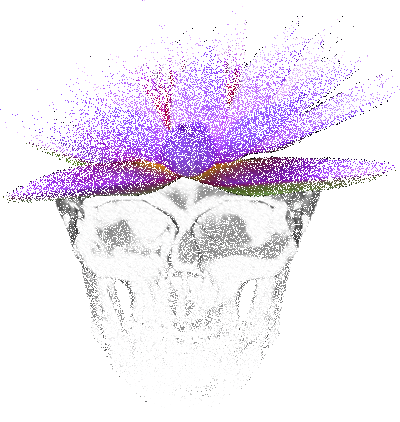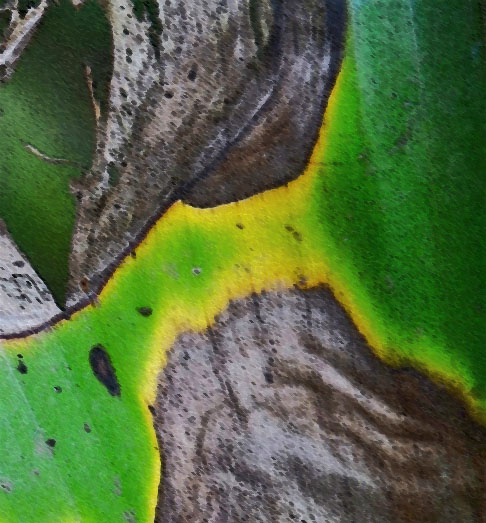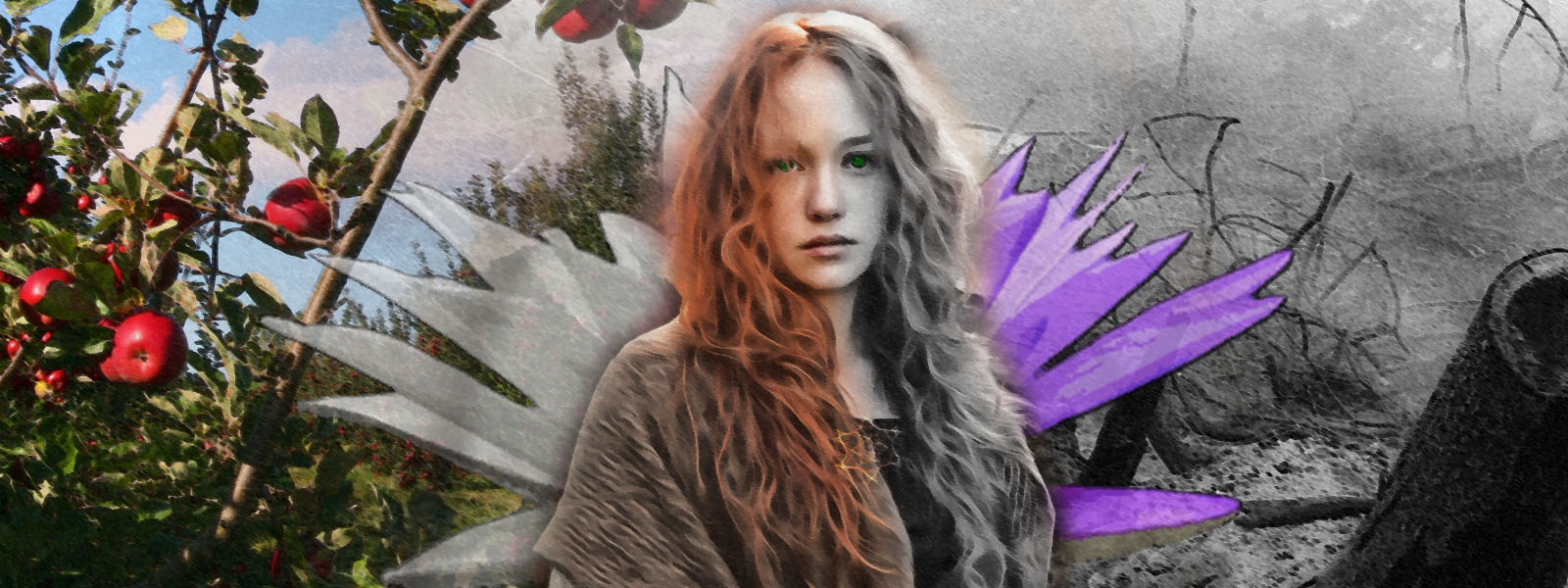"By the gates, Ruby, what is going on with the trees!?" Ruben Severlin resisted the urge to touch the black veins covering the bark of the elm in front of him, each dark, jagged strand erupting from a strange growth that had the apparent consistency of a mushroom and the shape of a lily-like flower of purple hue.
His sister grabbed him by the shoulder: "Step back, Ruben! Something is happening to the forest!" Fear quivered in her voice.
As he looked about, the blackness suddenly pulsed, permeating their surroundings, and the forest, once so friendly and inviting, now dark and foreboding, suddenly collapsed all around them, each tree turning into a tiny heap of ash. There was no brush, no leaf, no blade of grass left, and to his horror, Ruben could see several strands of Ruby's beautiful black hair whiten as the
blight licked her soul. In her terrified gaze he could see that he, too, had not been spared this horrifying fate. But the worst was yet to come: the forest, now turned into a barren plain, revealed to them the war band of Kaltani they had tried to outrun. They could no longer escape their pursuers.
— The final moments of Ruben and Ruby Severlin
The Disease
Brynwain Fever is a parasitic fungus that can gorge itself on soul power
1Soul power is the latent energy that souls generate just by existing. It is used to resonate with the Great Clockwork to unleash magic into the world. A soul has, according to modern soul theory, two quantities attached to it: soul power and soul flops, the latter measuring its computational power. Soul power has been quantified using the unit
Kunibert, which is based on
De Vries Cluster Field Theory.
. It was developed by the grand druid Brynwain of the Kaltani in 114 AH to decimate the crops of the
Middlish and
Yamato people.
Special Incidents
An infamous epidemic of Brynwain Fever occurred when
the magical storm Asteria Magna carried infected pollen all the way to the Glade of Druith
2North of the Brammenwoods lies the Glade of Druith, just past the great Lake of Glazglubin that is squeezed between the two forests. Druith is home to the Schamani of Druith, who stayed neutral during the Great War, much to the dismay of the other Nordmen and Old Gods. However, the whole Glade of Druith was declared a nature and culture preserve when the Null Concord was signed in the Age of Awakening, a point brought forth by the technocrats of the UOBT during the negotiations, and during the war efforts, the Nordmen were prevented from invading Druith by the Allied Forces.
, which had been declared a cultural and nature preserve during the signing of the Null Concord
3Near the end of the Age of Awakening, just after announcing themselves to the world, the Brotherhood of the Null forced the nations of the Great Land to the negotiation table, hammering out that any wars involving large scale magic must be waged on the Untamed Meadows on the ruins of Estverde, creating a 'balance of repercussions' that woud force all other signing nations to act immediately against offenders who broke the concord. The Null Concord additionally severely limits or forbids the development and deployment of high tier desctructive magic and technologocal weapons of mass destruction, counteracting a potential arms race between mages and technocrats to break out and a second Estverde to occur.
in 143 AH. The infection fatally spread to a large population of winterwhite willows
4Magical weeping-willow-like trees that grow around the perimeter of the Glade of Druith. They grow ice crystals on their long, hanging twigs, which fall to the ground as snow, suffocating other vegetation and creating a ring of snow around Druith.
that ringed the glade, causing them to wither away. This almost caused the Schamani of Druith
5Mages of Druith are called "schamani" and are closely tied into nature and magic that manipulates and empowers it. The word "druid" is used for such mages that do not belong to the tribe of Druith and is actually based on the word "Druith". No druid would call themselves schamani, but sometimes Nordmen in awe of a magus's power will call them such to show their reverence.
to break their ironclad neutrality and retaliate against their Kaltani brethren, a turn in the war only averted by Brynwain herself, who went to Druith to help the efforts to regrow the perimeter of the glade.
Born from powerful animancy
6The colloquially demonized magic art of “necromancy” stems from a field of research actually named “animancy”, the study of manipulating and transplanting souls. Since the power of a soul has been connected with extraordinary longevity since before the
Reshaping of the World, many powerful druids and mages have sought to attain immortality by manipulating their souls or even by bending others to their purpose. The latter has caused much fear among ordinary folk for all of human memory, as souls could be used to augment one’s powers and even raise the dead in a way, though this was usually tied to certain complications. Additionally, pursuers of the darker venues of animancy tended to suffer gruesome fates, causing people to believe that
the Great Clockwork frowned upon such practices.
, brynwain lilies, the tiny, flower-like corpora of the fungus that cause Brynwain Fever, bloom out of the stems of all plants in the vicinity of the magic ritual of Brynwain. None but herself have ever been able to reproduce the sickness.
Once the brynwain lilies bloom, the infected plant becomes a carrier, and bees and other pollen-carriers transmit it to close-by plants. However, the fever has a set gestation time that is carried into new generations, a gestation time that is global, not local, meaning two trees infected by the same wave of Brynwain Fever at different times will follow a simultaneous progression. This limits the potential spread radius statistically and was intentionally included in the disease by Brynwain to prevent a mass-extinction of all plant-life on Aqualon.
The full progression of Brynwain Fever takes eight days, after which all infected specimens will wither into piles of black ash.
Brynwain Fever caused a lot of problems for the enemies of the Nordmen. Entire crops were lost in the Middle Lands and the Yamato Mountain range, and orchards were ravaged left and right.
In order to combat this pressing issue, the margraves of the Middle Lands called a special magus council into session to research counter
magic that could combat the condition. In addition, the grand druid Brynwain was declared enemy #1 of the Allied Forces, even before Allfather Odin, the most feared general of the Nordmen.
In the end, a time intensive treatment was devised where a
Brother or Sister of the Null has to completely nullify all magic within an infected area; then workers have to cut the brynwain lilies diligently out of the infected plants.
A more common treatment, though costly, was to simply burn the fields or orchards down to reclaim the soil, which would otherwise have been tainted for some time. This of course still caused huge loss of crops, putting the food supply during the war time in danger.
The Brynwain Fever was feared by the population. As black discolorations would grow in intricate patterns from the brynwain lilies, the vegetation would grow darker and more threatening, and people close to large outbreaks would grow sick and feeble; some of them would even develop
spellblight, the most stigmatized
sickness in all of Aqualon. This was caused by the fungus absorbing latent soul power from not only the plants and animals in the area but also the people to gorge itself and ultimately run its course.
There were also unconfirmed reports that larger effected plants, such as old trees, emitted an aura of malice and even attacked people before ultimately turning to ash, so fear of Brynwain Fever was prevalent throughout the Age of Heroes.
7Gruesome tales of the animancy forced into those trees and how they developed a thirst for blood are told to this day and actually inspired a new sub-genre of horror fiction in
The Middle Lands








Comments